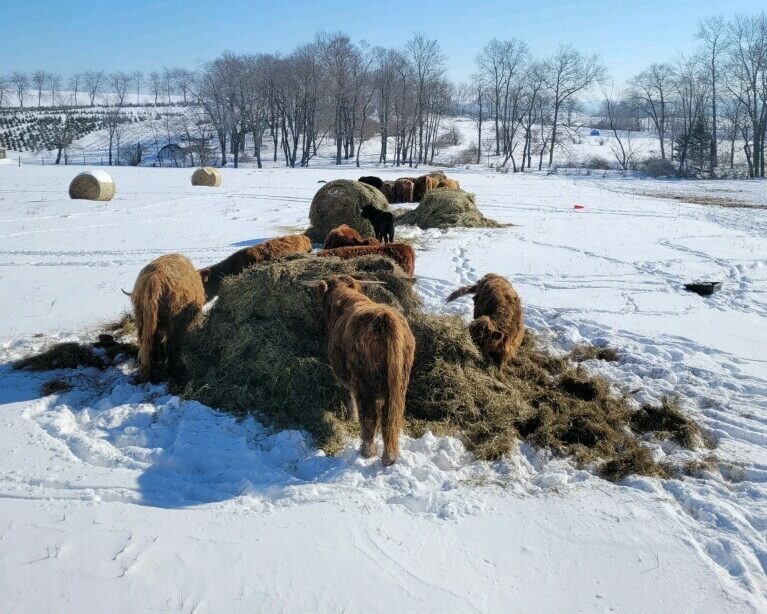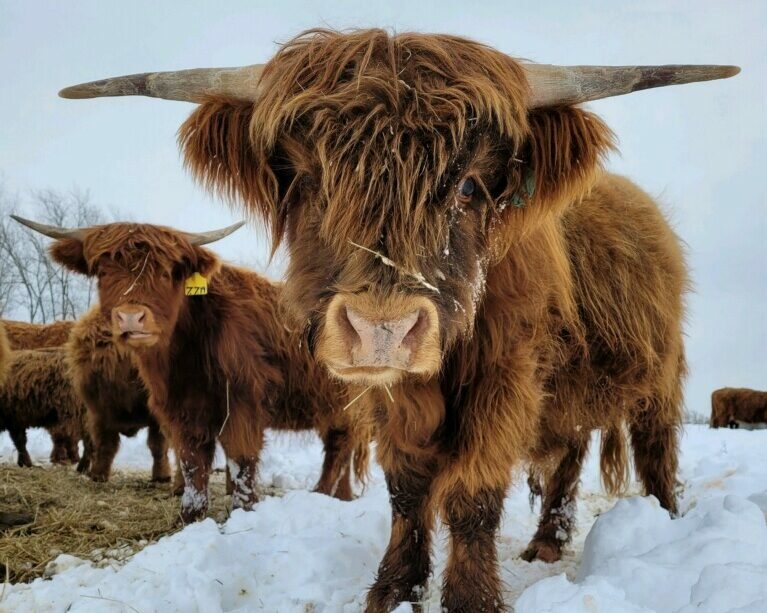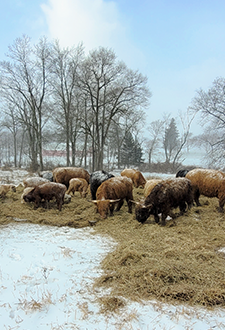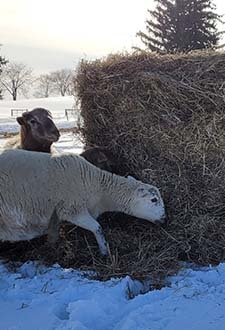BLOG

Benefits of Bale Grazing
As temperatures cool off and the breeze whispers of long sleeves, apple cider, and autumn, farmers and ranchers are whisked away by thoughts of winter. Winter brings different feelings for different folks, but it undoubtedly conjures challenges to rearing livestock. Freezing and thawing, pasture conditions, and supplemental hay feeding are among the top concerns as winter approaches. Technology and practices are evolving to make these winter hardships more manageable. One practice gaining ground across the country is Bale Grazing.

At first sight, those two words don’t seem to go together. Bales are used when grazing season has ended. Grazing refers to the method of animal-pruned grasses and other standing forages, how does one “graze” a bale for that matter? Bale grazing referrers to strategic placement of bales on winter pasture and providing controlled access to them over the course of the non-growing season.
In years past, farmers and ranchers used to feed hay out on the field using methods like swath or windrow feeding. Hay was dropped and gathered into swaths and made available for cattle in the winter months. These methods were abandoned as advancement and “efficiency” suggested winter hay lots and sacrifice paddocks were a better option. Today, it is common practice to pull animals from the pasture and feed hay in the barn, barnyard, or sacrifice area until forage is back in full swing. Trailing in the wake of winter feeding lots is a portion of land that often does not recover for the growing season due to over concentration of nutrients and excess cover. Advantages fall on both sides of this fence, but many now argue the benefits of bale grazing outweigh the convenience of hay lot feeding.
WINTER WOES
Anyone in a colder environment will attest to the joys of fickle farm equipment during winter months. Batteries die, tractors need encouragement to turn over, and any other small task is less and less pleasant as temperatures drop. Typical hay feeding relies on frequent equipment use, both for setting out fresh hay, providing clean bedding, and removing manure. Fuel costs are on the rise. This is a growing operation expense, not to mention the winter abuse machinery incurs. What if I told you all of these tasks and costs could be traded for a few days of minimal prep in warmer weather? That’s exactly what bale grazing offers.

LAND PLANNING
Bale grazing begins with a plan. It is strategic because the results not only benefit the farmer or rancher but the land as well. Veteran bale graziers encourage the targeting of poor-quality soils or acreage in need of a boost. Choosing higher or hard ground is advantageous for most winter ground conditions. Every region experiences different winter conditions – wet, freezing and thawing, frozen solid, etc. These conditions are specific to your context and need to be taken into consideration as you consider bale grazing on your land. It is true, some land is better suited for bale grazing but more and more managers are finding ways to implement this practice in a variety of climates. Operations spanning from the pacific northwest, up into Canada, down to Missouri, and through Pennsylvania and New England have all proven successful use of this winter-feeding formula. Evaluate your landscape. Where might ground conditions favor bale grazing? Which of these areas need a boost?

BOOST BY THE BALE
What kind of boost are we talking here? The kind that can reduce or eliminate the purchase of fertilizers. Most operations do not use hay rings when bale grazing. The amount of waste will depend on the quality of the hay. Cattle will make the effort to clean up crumbs of quality hay but will shrug at the spreading of lesser quality bales. “Wasted” hay is inevitable, but that’s the point! This remaining hay litter is waste in the eyes of the worker but is welcomed in the appetite of the soil. Cover is always beneficial to the soil. Cover improves water cycling, reduces erosion, and jump starts the mineral cycle as organic matter is delivered directly where it is needed – the soil surface.
Soil monitoring tip: The soil surface will be the leading indicator of soil health and what’s happening on your land. Most of the story is told right there on the first page. Open up the book and start reading!
Almost as if planned, this litter also doubles as bedding for the livestock. No need to clean pens or bring in bedding. The litter is the bedding, the bedding is the cover, the cover is the organic matter, the organic matter is the soil food. That’s a win win win... win!

DIRECT DEPOSIT
Plant and soil health will improve from the direct application and capture of nutrients from litter and residues and manure deposits. Manure is just that, a deposit – a form of farm currency. It’s next to gold! Just the presence of ruminants on a landscape can introduce microbes and beneficial microscopic critters just from adding their manure and saliva. When bale grazing, this manure is deposited directly on the pasture or hay field. In typical winter hay lots, manure is gathered and stored to be spread at a later date. Studies have shown some bale grazing systems capture and return three times as much nitrogen than hauled manure from those hay lots. This loss of potency can be attributed to leaching and volatilization as it escapes as a gas while being stored.
Some bale grazing studies show a 34% recovery rate of nitrogen from the original bale. The combination of hay litter and directly applied manure results in longer lasting benefits than commercial fertilizer application. It is the more natural method, after all. Often times, hauling bales to a targeted area will provide cheaper and longer lasting improvement than the purchase of fertilizer.








